biochemical and haematological profile - Universitatea de Ştiinţe ...
biochemical and haematological profile - Universitatea de Ştiinţe ...
biochemical and haematological profile - Universitatea de Ştiinţe ...
You also want an ePaper? Increase the reach of your titles
YUMPU automatically turns print PDFs into web optimized ePapers that Google loves.
<strong>Universitatea</strong> <strong>de</strong> Științe Agricole și Medicină Veterinară Iași<br />
of hatched embryos represented approximately 60% (45 to 75%) of the collected eggs. The<br />
vesiculated eleuthero‐embryos were transferred in 12 wells microplates (5 eleuthero‐embryos<br />
in 2ml medium/well). Negative controls <strong>and</strong> MCLR media were not changed during the 48<br />
hours experimental procedure. The vesiculated fish larvae being fully autotrophic, no food was<br />
given during the time course of the 48h experimental period. Non‐invasive observations of<br />
eleuthero‐embryos behavior were performed <strong>and</strong> eleuthero‐embryos were h<strong>and</strong>led in<br />
accordance with European Union regulations concerning the protection of experimental<br />
animals.<br />
Histopathology process<br />
At the end of the immersion experiment, surviving hatched embryos treated or not (control)<br />
with MC‐LR were fixed in buffered formal<strong>de</strong>hy<strong>de</strong> solution 10% (v/v) for 24h. Fixed embryos<br />
were then clarified <strong>and</strong> <strong>de</strong>hydrated in successive baths of ethanol (70% <strong>and</strong> 95%) <strong>and</strong> butanol,<br />
<strong>and</strong> finally transferred into baths of liquid paraffin at 56°C. They were individually oriented <strong>and</strong><br />
embed<strong>de</strong>d into blocks of paraffin wax. Transverse sections (3,5µm thickness) were hydrated in<br />
successive baths of ethanol (100% <strong>and</strong> 95%) <strong>and</strong> routinely stained with Hematoxyline‐Eosine‐<br />
Saffron (HES, Sigma‐Aldrich, France). Microphotograph observations of histological transverse<br />
sections were carried out with an Axio‐Imager Z1 Zeiss microscope at various magnifications.<br />
The all embryo being cut, an constant anatomical level was chosen in the pectoral fin region to<br />
perform observations on intestine <strong>and</strong> liver.<br />
Immunohistochemistry process<br />
Sections of paraffin‐embed<strong>de</strong>d tissues were <strong>de</strong>paraffined in toluene <strong>and</strong> hydrated gradually in<br />
ethanol (100% <strong>and</strong> 95%), washed in distilled water <strong>and</strong> then in 10mM phosphate buffered<br />
saline (PBS, Sigma‐Aldrich, France). Tissue sections were microwaved in 10mM citrate buffer,<br />
pH 6.0 for 30min (350w microwave oven). Two different primary anti‐MCLR monoclonal<br />
antibodies (Alexis Biochemicals, Switzerl<strong>and</strong>) were tested: AD4G2 which recognizes all<br />
microcystins because of its Adda specification <strong>and</strong> MC10E7 which recognizes all 4‐Arg<br />
microcystins. The immunoassay was routinely performed with the NexES system (Ventana,<br />
Tucson, USA). As positive control, we choose an adult medaka fish liver, which procee<strong>de</strong>d from<br />
a gavage experiment with MCLR (Mezhoud <strong>and</strong> al, 2008), <strong>and</strong> tissue sections procee<strong>de</strong>d<br />
without primary antibody were chosen as negative control.<br />
Transmission electron microscopy<br />
Embryos were preserved in 0.5% glutaral<strong>de</strong>hy<strong>de</strong> in 2% paraformal<strong>de</strong>hy<strong>de</strong> solution for<br />
transmission electron microscopy study during 24 hours <strong>and</strong> then, washed three times in<br />
Sorensen phosphate buffer (0.1M, pH 7.4) in three successive 10min baths; finally embryos<br />
were <strong>de</strong>hydrated in ethanol (50°, 70°, 90° <strong>and</strong> 100°) by three baths at each step of <strong>de</strong>hydration<br />
<strong>and</strong> the embed<strong>de</strong>d in a epoxy mixture (Spur). Medium <strong>and</strong> ultrathin sections were sliced with<br />
diamond knives (Diatome) on a Reichert‐Jung Ultracut microtome. Ultrathin sections on grid<br />
were then observed by transmission electronic microscope (Hitachi H 700S) with a camera<br />
(LCD, Hamamatsu) at various magnifications.<br />
38



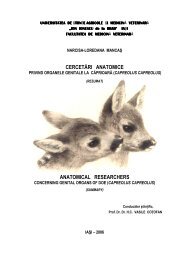
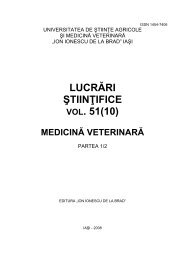
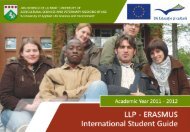
![rezumat teză [RO]](https://img.yumpu.com/19764796/1/190x245/rezumat-teza-ro.jpg?quality=85)
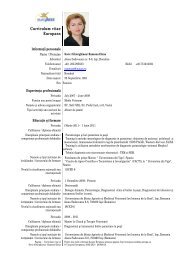



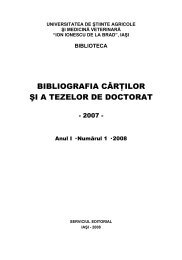
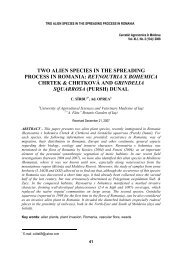
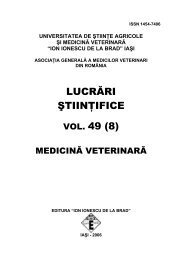
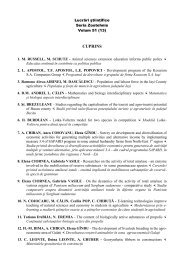
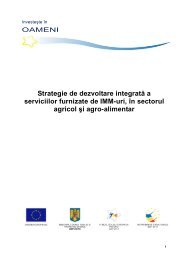
![rezumat teză [RO] - Ion Ionescu de la Brad](https://img.yumpu.com/14613555/1/184x260/rezumat-teza-ro-ion-ionescu-de-la-brad.jpg?quality=85)
